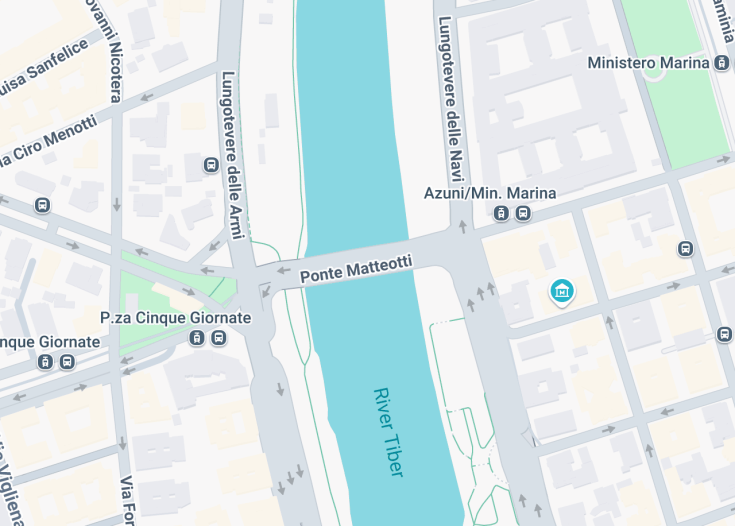Ponte Giacomo Matteotti, an architectural gem in Rome, serves as both a vital transport link and a historical monument. Spanning the Tiber, this majestic bridge connects the bustling lungotevere Arnaldo da Brescia with piazza delle Cinque Giornate, enriching the cityscape with its elegant design and storied past.
Visitors are encouraged to explore the area surrounding the bridge, which offers scenic views and vibrant local culture. Take time to enjoy a leisurely stroll along the Tiber’s banks, where the atmosphere exudes the charm of Rome.
For a unique experience, consider visiting Ponte Giacomo Matteotti during sunset. The warm glow enhances the picturesque scenery of the bridge and its surroundings, making it an ideal backdrop for memorable photographs.
Description of Ponte Giacomo Matteotti in Rome, Italy
Ponte Giacomo Matteotti is an elegant arch bridge that spans the Tiber River, connecting lungotevere Arnaldo da Brescia with piazza delle Cinque Giornate in Rome. Designed by the esteemed architect Augusto Antonelli, the bridge showcases three substantial archways constructed from durable masonry. With a total length of approximately 138.6 meters and a width of 20.1 meters, the structure exemplifies the architectural style of the 1920s while incorporating elements speaking to its historical significance.
The bridge was initially unveiled on April 21, 1929, under the name of “Ponte del Littorio,” reflecting the political climate of Italy at the time. However, its name was later changed in the post-World War II period to pay homage to Giacomo Matteotti, a prominent political figure who was kidnapped and murdered nearby, symbolizing the bridge’s deep connection to Italian political history.
Ponte Giacomo Matteotti stands out not only for its architectural beauty, but also for the historical narratives it embodies, linking the past with the present as it continues to serve as a vital thoroughfare within the city’s urban landscape.
History
1924-1929: Construction
The construction of Ponte Giacomo Matteotti began in 1924, envisioned as Ponte delle Milizie. The project was led by architect Augusto Antonelli, who aimed to create a bridge that would seamlessly blend functionality with aesthetic appeal. The bridge was completed in 1929 after five years of meticulous work.
1929: Inauguration
On April 21, 1929, the bridge was inaugurated as Ponte del Littorio. This name reflected the fascist regime’s ideology of the time, associating the bridge with state power. Its grand opening was a significant event, celebrated with various civic ceremonies that highlighted its importance in the socio-political landscape of Rome.
Post-World War II: Renaming
After the conclusion of World War II, the bridge underwent a transformation in its symbolic representation. In acknowledgment of its historical context related to Giacomo Matteotti’s tragic fate, it was renamed Ponte Giacomo Matteotti. This change served to honor Matteotti’s legacy and his resistance against the fascist regime.
Activities Available at Ponte Giacomo Matteotti in Rome
Visitors to Ponte Giacomo Matteotti can enjoy a leisurely stroll across the bridge, taking in the scenic views of the Tiber River and the surrounding cityscape. The area is often frequented by tourists and locals alike, making it a perfect spot for photography and relaxation. Additionally, the bridge serves as a crucial connection for various public transportation options, including tram services, enhancing accessibility to popular attractions.
Architectural Significance and Design Features of Ponte Giacomo Matteotti in Rome
The bridge is celebrated for its striking architectural elements, particularly its three sweeping arches, which create a majestic visual impact. Made primarily of masonry, the design integrates traditional construction methods with modern engineering techniques of the 1920s, symbolizing a period of innovation in bridge design. The graceful curvature of the arches not only serves an aesthetic purpose but also facilitates the efficient flow of water beneath, showcasing the dual nature of beauty and functionality innate to the structure.
General informations
Location
Ponte Giacomo Matteotti is located in Rome, near the Tevere River. It connects lungotevere Arnaldo da Brescia to piazza delle Cinque Giornate, positioned in both the Prati and Flaminio neighborhoods.
Address:
Ponte Matteotti, 00192 Roma RM, ItalyVisiting Information
The bridge can be visited freely at any time, making it a pleasant spot for a stroll or a quick photo opportunity. Early mornings or late afternoons are ideal for avoiding crowds and enjoying better lighting for photography.
How to reach Ponte Giacomo Matteotti
Car
Ponte Giacomo Matteotti is easily accessible by car. There is street parking available nearby, though it may be limited during peak hours.
| Route | Distance | Travel time |
|---|---|---|
| From Termini Station | 3.5 miles (5.6 km) | 15 minutes |
| From Vatican City | 1.5 miles (2.4 km) | 10 minutes |
| From Trastevere | 3 miles (4.8 km) | 15 minutes |
Public Transport
The easiest way to reach Ponte Giacomo Matteotti using public transport is via tram. Tram line 19 stops near the bridge, providing a convenient option for visitors.
| Route | Distance | Travel time |
|---|---|---|
| From Termini Station | 3 miles (4.8 km) | 20 minutes |
| From Vatican City | 1.5 miles (2.4 km) | 15 minutes |
| From Trastevere | 2.5 miles (4 km) | 25 minutes |
Accessibility and Limitations
Ponte Giacomo Matteotti is generally accessible for visitors, providing a smooth walking path across the bridge.
Accessibility
Limitations
- Potential pedestrian congestion during peak hours.
- Restricted access during maintenance work or events.
Notes to visitors
- There may be limited seating along the bridge.
- Be cautious of bike traffic as the area can get busy.
Common questions
What is the architectural style of Ponte Giacomo Matteotti?
The Ponte Giacomo Matteotti is designed in a classical architectural style, specifically as an arch bridge. Its construction features three prominent arches made of masonry, which not only serve a structural purpose but also give the bridge an elegant appearance. The design reflects the architectural trends of the time when it was built, showcasing a blend of functionality and aesthetics that is characteristic of early 20th-century civil engineering in Rome. The use of robust materials, combined with the arched form, creates a timeless elegance and adds to its significance as a landmark in the city.
What notable features or decorations can be found on Ponte Giacomo Matteotti?
Ponte Giacomo Matteotti is adorned with several notable architectural features and decorations that enhance its appeal. Among these are the decorative masonry work along the bridge’s facade, including intricate stone carvings and detailed cornices that reflect the craftsmanship of the era. Additionally, the bridge features large stone balustrades that not only serve a protective function but also contribute to its overall aesthetic. The arches are elegantly designed, lending a sense of gracefulness to the structure as it spans the Tiber River. Overall, these features combine to create a visually striking monument that captures the essence of its historical context.
Are there any activities or experiences to enjoy around Ponte Giacomo Matteotti?
Around Ponte Giacomo Matteotti, visitors can enjoy a variety of activities and experiences that highlight the bridge’s scenic setting and cultural significance. Here are some suggestions:
- Stroll along the Tiber River: The area surrounding the bridge offers picturesque views of the river and cityscape, making it perfect for leisurely walks.
- Photographic opportunities: The design and structure of the Ponte Giacomo Matteotti provide excellent backdrops for photography, especially during sunrise and sunset when the light casts beautiful shadows.
- Dine at nearby restaurants: Explore local dining options near the bridge where you can savor authentic Roman cuisine while enjoying views of the Tiber.
- Visit nearby landmarks: The bridge is close to several cultural institutions and historical sites, making it easy to include in a broader exploration of the city.
Whether you choose to relax by the riverside or engage in urban exploration, the areas surrounding Ponte Giacomo Matteotti provide ample opportunities for memorable experiences.
What is the best time to photograph Ponte Giacomo Matteotti?
The best time to photograph Ponte Giacomo Matteotti is during the golden hours of early morning and late afternoon. During these times, natural light creates a warm, soft glow that enhances the beauty of the bridge and its surroundings. The gentle illumination highlights the intricate architectural details and casts pleasing shadows that add depth to photography.
Additionally, capturing the sunset can yield stunning images of the bridge silhouetted against the vibrant colors of the sky. If you’re interested in nighttime photography, the bridge is elegantly illuminated, providing a mesmerizing contrast against the dark sky, which is perfect for creating dramatic effects in your photos.
Ultimately, the time of day you choose can significantly impact the ambiance and overall mood of your photos, so consider planning your visit accordingly.
Are there any local legends or stories associated with Ponte Giacomo Matteotti?
Ponte Giacomo Matteotti is linked to various local legends and stories that add to its cultural significance. One of the most notable tales relates to its original name, Ponte del Littorio, which connected it to the era of Fascism in Italy. Many locals recall stories of political events that occurred near the bridge, especially those concerning the infamous abduction of Giacomo Matteotti, an Italian politician who was kidnapped nearby in 1924. His disappearance and subsequent murder became a symbol of the political unrest of that time.
Moreover, as one of the bridges spanning the Tiber, it has witnessed numerous pivotal events in Roman history. Visitors often hear anecdotes from locals about how the bridge served as a vantage point during various epochs, from ancient Roman times to the present day.
While these legends and stories may vary, they contribute to the rich narrative tapestry surrounding Ponte Giacomo Matteotti, making it not just a functional piece of infrastructure but a site of profound historical and cultural resonance.

Is the Ponte Giacomo Matteotti in Rome worth visiting?
The Ponte Giacomo Matteotti, originally known as the ponte del Littorio, is not just a functional structure; it stands as a symbol of Rome’s rich history. Completed in 1929 and later dedicated to political figure Giacomo Matteotti, the bridge features stunning architechture with three impressive arches made of traditional masonry.
Visitors will appreciate its scenic views over the Tevere River, making it a lovely spot for photography. Furthermore, the bridge’s proximity to key attractions enhances its appeal. Even though it may not be a primary tourist destination, its historical significance and aesthetic charm are worth a brief visit—especially for those keen on exploring Roman architecture. Plus, it’s easily accessible via tram, further boosting its appeal for tourists.









